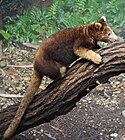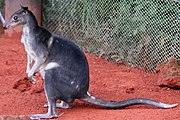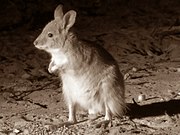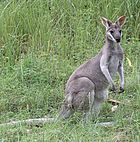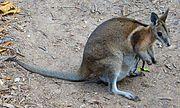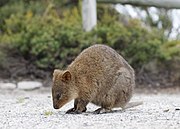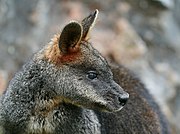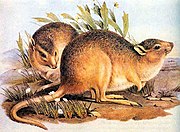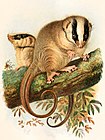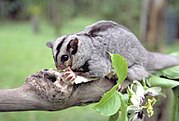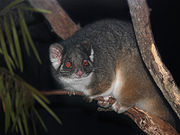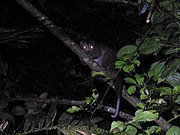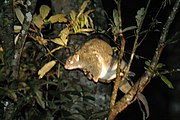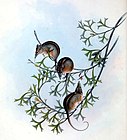Diprotodontia is an order of Australian marsupial mammals. Members of this order are called diprotodonts. Diprotodontia is the largest order of marsupials and currently comprises 140 extant species, which are grouped into 39 genera. They are found in Australia, New Guinea, and Indonesia, in forests, shrublands, grasslands, and savannas, though some species are found in deserts and rocky areas. They come in a wide array of sizes, ranging from the Tasmanian pygmy possum, at 5 cm (2 in) plus a 6 cm (2 in) tail, to the red kangaroo, at 160 cm (63 in) plus a 120 cm (47 in) tail.

Diprotodontia is subdivided into three suborders: Macropodiformes, Phalangeriformes, and Vombatiformes. Macropodiformes has 72 species in 3 families: Hypsiprymnodontidae, Macropodidae, and Potoroidae, and includes kangaroos, wallabies, bettongs, potoroos, and rat-kangaroos. Phalangeriformes has 64 species in 6 families: Acrobatidae, Petauridae, Pseudocheiridae, Tarsipedidae, Burramyidae, and Phalangeridae, and includes cuscus and the brushtail, ringtail, and gliding possums. Vombatiformes has only four species in two families: Phascolarctidae, the koala, and Vombatidae, the wombats. The classification of species in the order is not fixed, with many recent proposals for changes made based on molecular phylogenetic analysis. Additionally, the present set of suborders was created beginning in 1997 by splitting the former suborder Phalangerida into Macropodiformes and Phalangeriformes, and further reorganizations have been proposed.[1]
In addition to the extant species, eight species in the suborder Phalangeriformes—four in the family Macropodidae and four in Potoroidae—have been made extinct in the modern era, all between the 1880s and the 1940s after the colonization of Australia began: the broad-faced potoroo, crescent nail-tail wallaby, desert bettong, desert rat-kangaroo, eastern hare-wallaby, Lake Mackay hare-wallaby, Nullarbor dwarf bettong, and toolache wallaby. Dozens of extinct, prehistoric Diprotodont species have also been discovered, though due to ongoing research and discoveries the exact number and categorization is not fixed.[2]
Conventions
Range maps are provided wherever possible; if a range map is not available, a description of the collective range of species in that genera is provided. Ranges are based on the International Union for Conservation of Nature (IUCN) Red List of Threatened Species unless otherwise noted. All extinct genera or species listed alongside extant species went extinct after 1500 CE, and are indicated by a dagger symbol "†".
Classification
The order Diprotodontia consists of 140 extant species belonging to 39 genera. This does not include hybrid species or extinct prehistoric species. Modern molecular studies indicate that the 39 genera can be grouped into 11 families; these families are grouped into the suborders Macropodiformes, Phalangeriformes, and Vombatiformes, and many are further grouped into named clades or subfamilies. In addition to the extant species, eight species in the suborder Phalangeriformes—four in the family Macropodidae and four in Potoroidae, including one extinct genus—have been made extinct in the modern era, all between the 1880s and the 1940s after the colonization of Australia began.
Suborder Macropodiformes
- Family Hypsiprymnodontidae (musky rat-kangaroo): 1 genus, 1 species
- Family Macropodidae
- Subfamily Macropodinae (kangaroos and wallabies) 12 genera, 66 species (4 extinct)
- Subfamily Sthenurinae (banded hare-wallaby) 1 genera, 1 species
- Family Potoroidae (bettongs, potoroos, and rat-kangaroos) 4 genera (1 extinct), 9 species (2 extinct)
Suborder Phalangeriformes
- Superfamily Petauroidea
- Family Acrobatidae (feather-tailed possum and feather-tailed glider): 2 genera, 2 species
- Family Petauridae (possums): 3 genera, 11 species
- Family Pseudocheiridae
- Subfamily Hemibelideinae (greater gliders): 2 genera, 2 species
- Subfamily Pseudocheirinae (ringtail possums): 3 genera, 11 species
- Subfamily Pseudochiropsinae (ringtail possums): 1 genus, 5 species
- Family Tarsipedidae (honey possum): 1 genus, 1 species
- Superfamily Phalangeroidea
- Family Burramyidae (pygmy possums): 2 genera, 5 species
- Family Phalangeridae
- Subfamily Ailuropinae (bear cuscus): 1 genus, 2 species
- Subfamily Phalangerinae (cuscus): 5 genera, 25 species
Suborder Vombatiformes
- Family Phascolarctidae (koala): 1 genus, 1 species
- Family Vombatidae (wombats): 2 genera, 3 species
Diprotodonts
The following classification is based on the taxonomy described by Mammal Species of the World (2005), with augmentation by generally accepted proposals made since using molecular phylogenetic analysis, as supported by both the IUCN and the American Society of Mammalogists.[5]
Suborder Macropodiformes
Hypsiprymnodontidae
| Name | Authority and species | Range | Size and ecology |
|---|---|---|---|
| Hypsiprymnodon (musky rat-kangaroo) | Ramsay, 1876 One species
| Northeastern Australia | Size: 20–35 cm (8–14 in) long, plus 6–13 cm (2–5 in) tail[6] Habitats: Forest[7] Diet: Insects, as well as worms, tuberous roots, and palm berries[6] |
Macropodidae
| Name | Authority and species | Range | Size and ecology |
|---|---|---|---|
| Dendrolagus (tree-kangaroo) | Müller, 1840 Fourteen species
| New Guinea and northeastern Australia | Size range: 41 cm (16 in) long, plus 40 cm (16 in) tail (Doria's tree-kangaroo) to 81 cm (32 in) long plus 94 cm (37 in) tail (dingiso)[8] Habitats: Forest and shrubland[9] Diets: Leaves, flowers, and fruit, as well as ferns, soft vines, cereals, grass, bark, nuts, insects, sap, bird eggs, and young birds[10] |
| Dorcopsis (dorcopsis) | Schlegel & Müller, 1842 Four species
| New Guinea | Size range: 34 cm (13 in) long, plus 27 cm (11 in) tail (brown dorcopsis) to 100 cm (39 in) long plus 40 cm (16 in) tail (black dorcopsis)[11] Habitats: Forest[12] Diets: Leaves, roots, grass and fruit[13] |
| Dorcopsulus (forest wallaby) | Matschie, 1916 Two species
| New Guinea | Size range: 31–46 cm (12–18 in) long, plus 22–41 cm (9–16 in) tail[14] Habitats: Forest[15] Diets: Leaves, fruit, buds, and stems[16] |
| Lagorchestes (hare-wallaby) | Gould, 1841 Four species
| Australia | Size range: 31 cm (12 in) long, plus 24 cm (9 in) tail (rufous hare-wallaby) to 49 cm (19 in) long plus 53 cm (21 in) tail (spectacled hare-wallaby)[17] Habitats: Desert, grassland, forest, shrubland, and savanna[18] Diets: Grass, forbs, herbs, seeds, fruit, sedges, and succulent shrubs[19] |
| Macropus (grey kangaroo) | Shaw, 1790 Two species
| Southern and eastern Australia | Size range: 85–140 cm (33–55 in) long, plus 75–100 cm (30–39 in) tail[20] Habitats: Savanna, grassland, shrubland, and forest[21] Diets: Grass, forbs, leaves, tree bark, and shrubs[22] |
| Notamacropus (brush wallaby) | Dawson & Flannery, 1985 Eight species
| Australia and southern New Guinea | Size range: 40 cm (16 in) long, plus 33 cm (13 in) tail (several) to 105 cm (41 in) long plus 75 cm (30 in) tail (red-necked wallaby)[23] Habitats: Shrubland, grassland, savanna, and forest[24] Diets: Grass, ferns, herbs, shrubs, bushes, and roots, as well as leaves and fruit[25] |
| Osphranter | Shaw, 1790 Four species
| Australia | Size range: 73 cm (29 in) long, plus 64 cm (25 in) tail (black wallaroo) to 160 cm (63 in) long plus 120 cm (47 in) tail (red kangaroo)[26] Habitats: Desert, grassland, forest, shrubland, and savanna[27] Diets: Grass and shrubs[28] |
| Onychogalea (nail-tail wallaby) | Gray, 1841 Three species
| Scattered Australia | Size range: 37 cm (15 in) long, plus 15 cm (6 in) tail (crescent nail-tail wallaby) to 70 cm (28 in) long plus 73 cm (29 in) tail (bridled nail-tail wallaby)[29] Habitats: Savanna, grassland, shrubland, and forest[30] Diets: Herbs, succulents, fruit, grass, forbs, and shrubs[31] |
| Petrogale (rock-wallaby) | Gray, 1837 Sixteen species
| Australia | Size range: 29 cm (11 in) long, plus 25 cm (10 in) tail (monjon) to 70 cm (28 in) long plus 70 cm (28 in) tail (allied rock-wallaby)[32] Habitats: Desert, grassland, forest, shrubland, rocky areas, and savanna[33] Diets: Grass and leaves, as well as shrubs, forbs, fungi, sedges, ferns, roots, bark, fruit, seeds and flowers[34] |
| Setonix (quokka) | Lesson, 1842 One species
| Southwestern Australia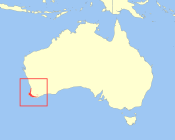 | Size: 39–60 cm (15–24 in) long, plus 23–35 cm (9–14 in) tail[35] Habitats: Forest, shrubland, and inland wetlands[36] Diet: Succulents, shrubs, forbs, grasses and sedges, as well as seeds, berries, and fruit[37] |
| Thylogale (pademelon) | Gray, 1837 Seven species
| New Guinea, eastern Australia, and Tasmania | Size range: 29–67 cm (11–26 in) long, plus 24–57 cm (9–22 in) tail (several)[38] Habitats: Savanna, grassland, shrubland, and forest[39] Diets: Grass, leaves, shoots, seeds, and fruit, as well as grass, bark, fungi, and cicadas[40] |
| Wallabia (swamp wallaby) | Trouessart, 1905 One species
| Eastern Australia | Size: 66–85 cm (26–33 in) long, plus 64–87 cm (25–34 in) tail[41] Habitats: Forest and shrubland[42] Diet: Buds, ferns, leaves, shrubs, and grasses, as well as bark and shoots from needle-leaf trees[41] |
| Name | Authority and species | Range | Size and ecology |
|---|---|---|---|
| Lagostrophus (banded hare-wallaby) | Thomas, 1887 One species
| Western Australia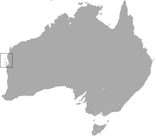 | Size: 40–46 cm (16–18 in) long, plus 32–40 cm (13–16 in) tail[43] Habitats: Shrubland[44] Diet: Plants and fruit[43] |
Potoroidae
| Name | Authority and species | Range | Size and ecology |
|---|---|---|---|
| Aepyprymnus (rufous rat-kangaroo) | Garrod, 1875 One species
| Northeastern Australia | Size: 37–52 cm (15–20 in) long, plus 35–40 cm (14–16 in) tail[45] Habitats: Forest and savanna[46] Diet: Grass, herbs, roots, tubers, and fungi, as well as carrion bones and larvae[45] |
| Bettongia (bettong) | Gray, 1837 Six species
| Australia | Size range: 27–44 cm (11–17 in) long, plus 26–35 cm (10–14 in) tail (northern bettong)[47] Habitats: Desert, forest, shrubland, and savanna[48] Diets: Leaves, seeds, fruits, nuts, tubers, bulbs, flowers, and fungi, as well as insects, resin, marine carrion, and small invertebrates[49] |
| Caloprymnus† (desert rat-kangaroo) | Thomas, 1888 One species
| Central Australia | Size: 25–29 cm (10–11 in) long, plus 29–38 cm (11–15 in) tail[50] Habitats: Desert[51] Diet: Leaves and stems, as well as insects[52] |
| Potorous (potoroo) | Desmarest, 1804 Four species
| Southwestern Australia, southeastern Australia, and Tasmania | Size range: 24–42 cm (9–17 in) long, plus 19–33 cm (7–13 in) tail (several)[53] Habitats: Shrubland, inland wetlands, and forest[54] Diets: Fungi, insects, grass, roots, and other vegetation[55] |
Suborder Phalangeriformes
Superfamily Petauroidea
Acrobatidae
| Name | Authority and species | Range | Size and ecology |
|---|---|---|---|
| Acrobates (feathertail glider) | Desmarest, 1818 One species
| Eastern Australia | Size: 6–8 cm (2–3 in) long, plus 7–8 cm (3 in) tail[56] Habitats: Forest[57] Diet: Honeydew and arthropods[56] |
| Distoechurus (feather-tailed possum) | Peters, 1874 One species
| New Guinea | Size: 10–12 cm (4–5 in) long, plus 6–12 cm (2–5 in) tail[58] Habitats: Forest[59] Diet: Nectar, pollen, insects, and soft fruit[58] |
Petauridae
| Name | Authority and species | Range | Size and ecology |
|---|---|---|---|
| Dactylopsila (triok) | Gray, 1858 Four species
| New Guinea and northeastern Australia | Size range: 17–32 cm (7–13 in) long, plus 16–40 cm (6–16 in) tail (several)[60] Habitats: Forest[61] Diets: Insects, fruit, and leaves[62] |
| Gymnobelideus (Leadbeater's possum) | McCoy, 1867 One species
| Southern Australia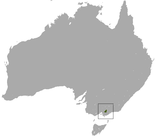 | Size: 15–17 cm (6–7 in) long, plus 14–18 cm (6–7 in) tail[63] Habitats: Forest[64] Diet: Insects, spiders, and sap[65] |
| Petaurus (wrist-winged gliders) | Shaw, 1791 Six species
| New Guinea and northern, eastern, and southern Australia | Size range: 12–32 cm (5–13 in) long, plus 15–48 cm (6–19 in) tail (various)[66] Habitats: Savanna and forest[67] Diets: Nectar, pollen, sap, gum, seeds, insects, arachnids, and small vertebrates[68] |
Pseudocheiridae
| Name | Authority and species | Range | Size and ecology |
|---|---|---|---|
| Hemibelideus (lemuroid ringtail possum) | Collett, 1884 One species
| Northeastern Australia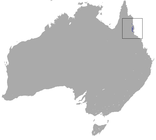 | Size: 30–38 cm (12–15 in) long, plus 30–35 cm (12–14 in) tail[69] Habitats: Forest[70] Diet: Leaves[69] |
| Petauroides (southern greater glider) | Thomas, 1888 One species
| Southeastern Australia | Size: 30–48 cm (12–19 in) long, plus 45–55 cm (18–22 in) tail[71] Habitats: Forest[72] Diet: Eucalyptus leaves[71] |
| Name | Authority and species | Range | Size and ecology |
|---|---|---|---|
| Petropseudes (rock-haunting ringtail possum) | Thomas, 1923 One species
| Northern Australia | Size: 33–38 cm (13–15 in) long, plus 20–27 cm (8–11 in) tail[73] Habitats: Rocky areas[74] Diet: Leaves, fruit, blossoms, and flowers, as well as termites[75] |
| Pseudocheirus (ringtail possum) | Ogilby, 1837 Two species
| Eastern, southern, and southwestern Australia | Size range: 28–40 cm (11–16 in) long, plus 28–36 cm (11–14 in) tail (Western ringtail possum)[76] Habitats: Savanna and forest[77] Diets: Leaves, as well as flowers, buds, nectar, fruit, bark, and sap[78] |
| Pseudochirulus (slender ringtail possum) | Matschie, 1915 Eight species
| New Guinea and northeastern Australia | Size range: 16 cm (6 in) long, plus 15 cm (6 in) tail (several) to 40 cm (16 in) long plus 47 cm (19 in) tail (Herbert River ringtail possum)[79] Habitats: Forest[80] Diets: Leaves, fruit, ferns, pollen, fungus, moss, and lichens[81] |
| Name | Authority and species | Range | Size and ecology |
|---|---|---|---|
| Pseudochirops (ringtail possum) | Matschie, 1915 Five species
| New Guinea and northeastern Australia | Size range: 28–41 cm (11–16 in) long, plus 25–38 cm (10–15 in) tail (several)[82] Habitats: Grassland and forest[83] Diets: Leaves as well as fruit[84] |
Tarsipedidae
| Name | Authority and species | Range | Size and ecology |
|---|---|---|---|
| Tarsipes (honey possum) | Gervais & Verreaux, 1842 One species
| Southwestern Australia | Size: 6–9 cm (2–4 in) long, plus 7–11 cm (3–4 in) tail[85] Habitats: Shrubland[86] Diet: Pollen and nectar[85] |
Superfamily Phalangeroidea
Burramyidae
| Name | Authority and species | Range | Size and ecology |
|---|---|---|---|
| Burramys (mountain pygmy possum) | Broom, 1895 One species
| Southeastern Australia | Size: 10–12 cm (4–5 in) long, plus 13–16 cm (5–6 in) tail[87] Habitats: Shrubland[88] Diet: Insects, spiders, seeds, and berries[89] |
| Cercartetus (pygmy possum) | Gloger, 1841 Four species
| New Guinea and northeastern and southern Australia | Size range: 5 cm (2 in) long, plus 6 cm (2 in) tail (Tasmanian pygmy possum) to 11 cm (4 in) long plus 16 cm (6 in) tail (long-tailed pygmy possum)[90] Habitats: Shrubland and forest[91] Diets: Nectar, pollen, invertebrates, and small lizards[92] |
Phalangeridae
| Name | Authority and species | Range | Size and ecology |
|---|---|---|---|
| Ailurops (bear cuscus) | Wagler, 1830 Two species
| Sulawesi island and Salibabu Island in Indonesia | Size range: 56–54 cm (22–21 in) long, plus 61–58 cm (24–23 in) tail (both species)[93] Habitats: Forest[94] Diets: Leaves, flowers, and fruit[95] |
| Name | Authority and species | Range | Size and ecology |
|---|---|---|---|
| Phalanger | Storr, 1780 Thirteen species
| New Guinea and nearby islands | Size range: 32–60 cm (13–24 in) long, plus 24–61 cm (9–24 in) tail (all species)[96] Habitats: Savanna and forest[97] Diets: Leaves, seeds, fruit, buds, vines, flowers, insects, small vertebrates, and eggs[98] |
| Spilocuscus | Gray, 1861 Five species
| New Guinea, nearby islands, and northeastern Australia | Size range: 33–64 cm (13–25 in) long, plus 31–59 cm (12–23 in) tail (several)[99] Habitats: Forest[100] Diets: Leaves, coconuts, fruit, insects, and small vertebrates[101] |
| Strigocuscus (dwarf cuscus) | Gray, 1861 Two species
| Sulawesi and nearby islands in Indonesia | Size range: 29–38 cm (11–15 in) long, plus 27–38 cm (11–15 in) tail (Sulawesi dwarf cuscus)[102] Habitats: Forest[103] Diets: Fruit, flowers, and leaves[104] |
| Trichosurus (brushtail possum) | Lesson, 1828 Four species
| Scattered Australia | Size range: 32–58 cm (13–23 in) long, plus 24–35 cm (9–14 in) tail (several)[105] Habitats: Savanna and forest[106] Diets: Leaves, shoots, fruit, flowers, fungi, lichen, buds, and insects, as well as bark[107] |
| Wyulda (scaly-tailed possum) | Alexander, 1918 One species
| Northwestern Australia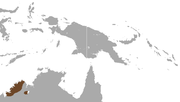 | Size: 29–47 cm (11–19 in) long, plus 25–33 cm (10–13 in) tail[108] Habitats: Forest, savanna, and rocky areas[109] Diet: Leaves[110] |
Suborder Vombatiformes
Phascolarctidae
| Name | Authority and species | Range | Size and ecology |
|---|---|---|---|
| Phascolarctos (koala) | Blainville, 1816 One species
| Eastern Australia | Size: 68–82 cm (27–32 in) long[111] Habitats: Forest and shrubland[112] Diet: Eucalyptus leaves, as well as other leaves[113] |
Vombatidae
| Name | Authority and species | Range | Size and ecology |
|---|---|---|---|
| Lasiorhinus (hairy-nosed wombat) | Gray, 1863 Two species
| Southern and eastern Australia | Size range: 77 cm (30 in) long (southern hairy-nosed wombat) to 111 cm (44 in) long (northern hairy-nosed wombat)[114] Habitats: Forest, savanna, and grassland[115] Diets: Grass and herbs[116] |
| Vombatus (common wombat) | Saint-Hilaire, 1803 One species
| Southern and southeastern Australia | Size: 70–110 cm (28–43 in) long[117] Habitats: Forest and shrubland[118] Diet: Leaves, grass, sedges, and moss, as well as shrubs, roots, tubers, and bark[117] |
References
Sources
- Groves, Colin P. (2005). Wilson, Don E.; Reeder, DeeAnn M. (eds.). Mammal Species of the World. Vol. 1 (3rd ed.). Johns Hopkins University Press. ISBN 978-0-8018-8221-0.
- Menkhorst, Peter; Knight, Frank (2011). A Field Guide to the Mammals of Australia (3rd ed.). Oxford University Press. ISBN 978-0-19-557395-4.
- Nowak, Ronald M. (2018). Walker's Mammals of the World. Vol. Monotremes, Marsupials, Afrotherians, Xenarthrans, and Sundatherians. Johns Hopkins University Press. ISBN 978-1-4214-2468-2.
- Nowak, Ronald M. (2005). Walker's Marsupials of the World. Johns Hopkins University Press. ISBN 978-0-8018-8222-7.
- Pattiselanno, Freddy; Koibur, Juohan F.; Arobaya, Agustina Y. S. (2020). Dabek, Lisa; Valentine, Peter; Blessington, Jacque; Schwartz, Karin R. (eds.). Tree Kangaroos: Science and Conservation. Elsevier. ISBN 978-0-12-814675-0.
- Richardson, Ken (2012). Australia's Amazing Kangaroos: Their Conservation, Unique Biology and Coexistence with Humans. CSIRO Publishing. ISBN 978-0-643-09739-1.
- Strahan, Ronald (1995). Mammals of Australia. Smithsonian Institution. ISBN 978-1-56098-673-7.
- Taylor, Barbara (2022). The Magnificent Book of Extinct Animals. Weldon Owen. ISBN 978-1-68188-737-1.

